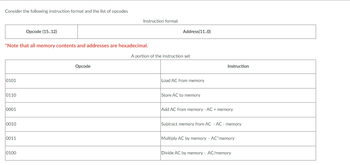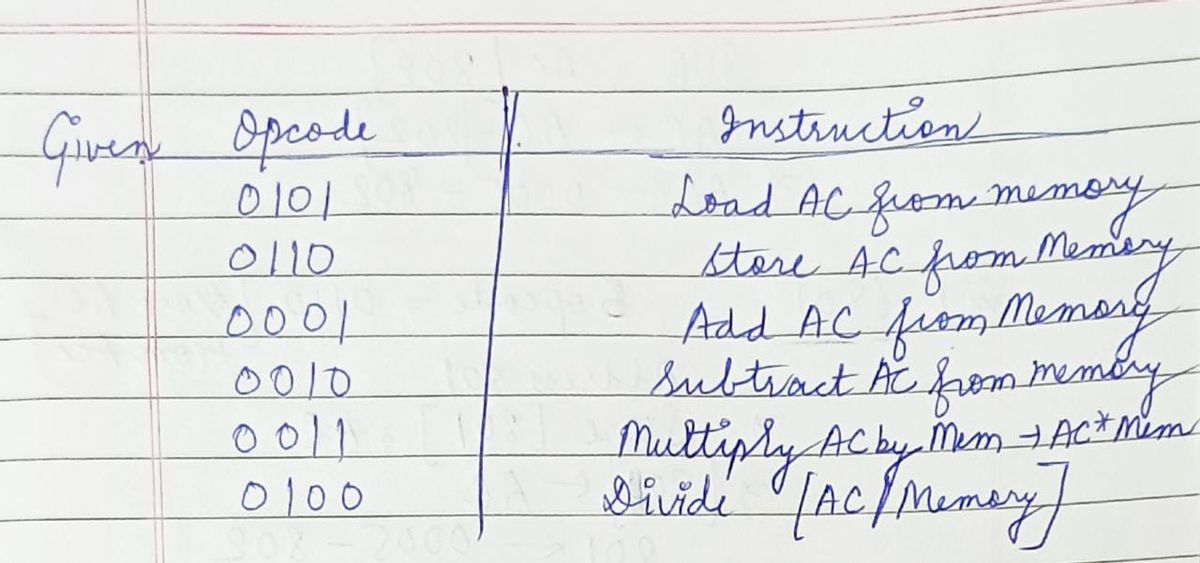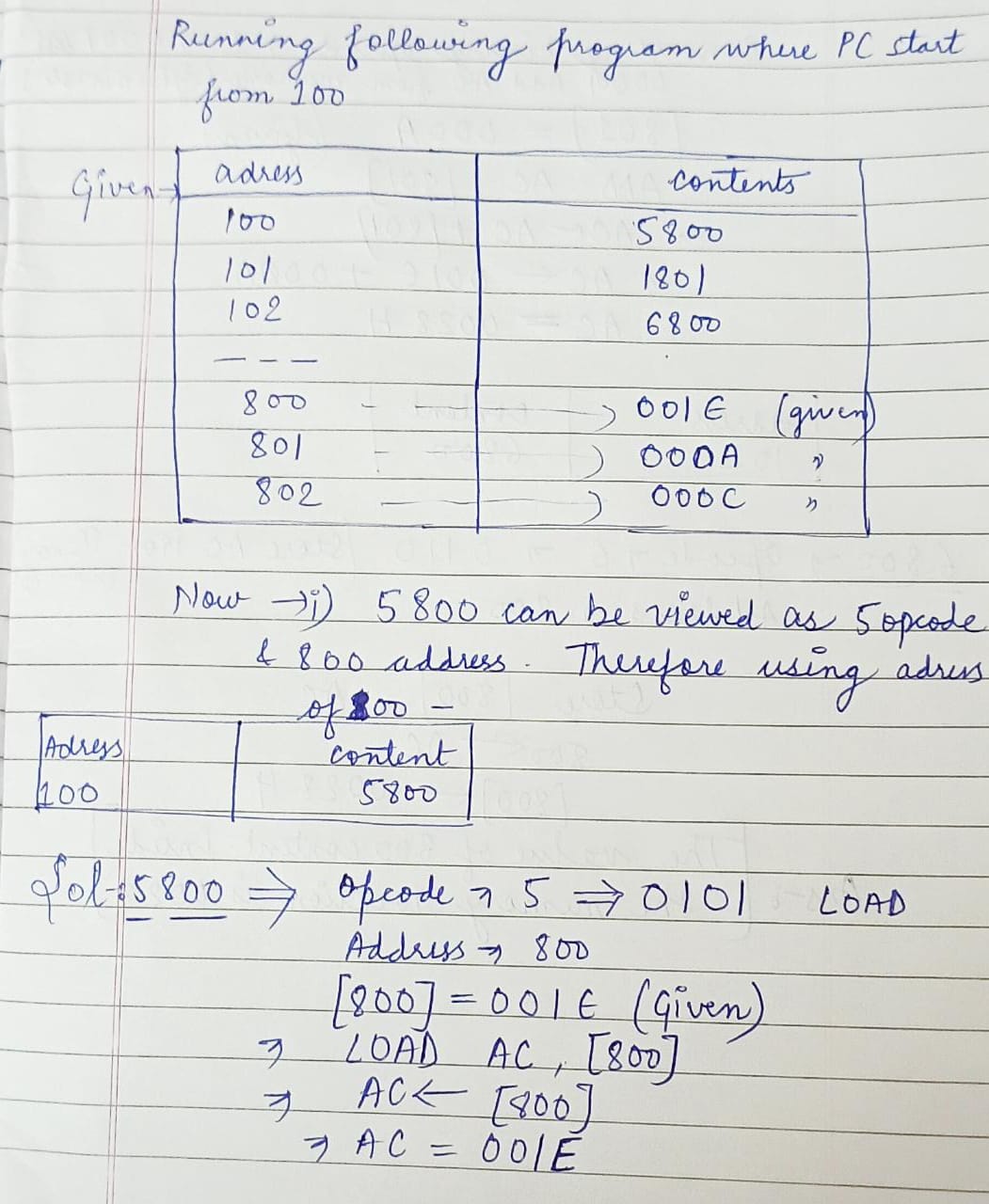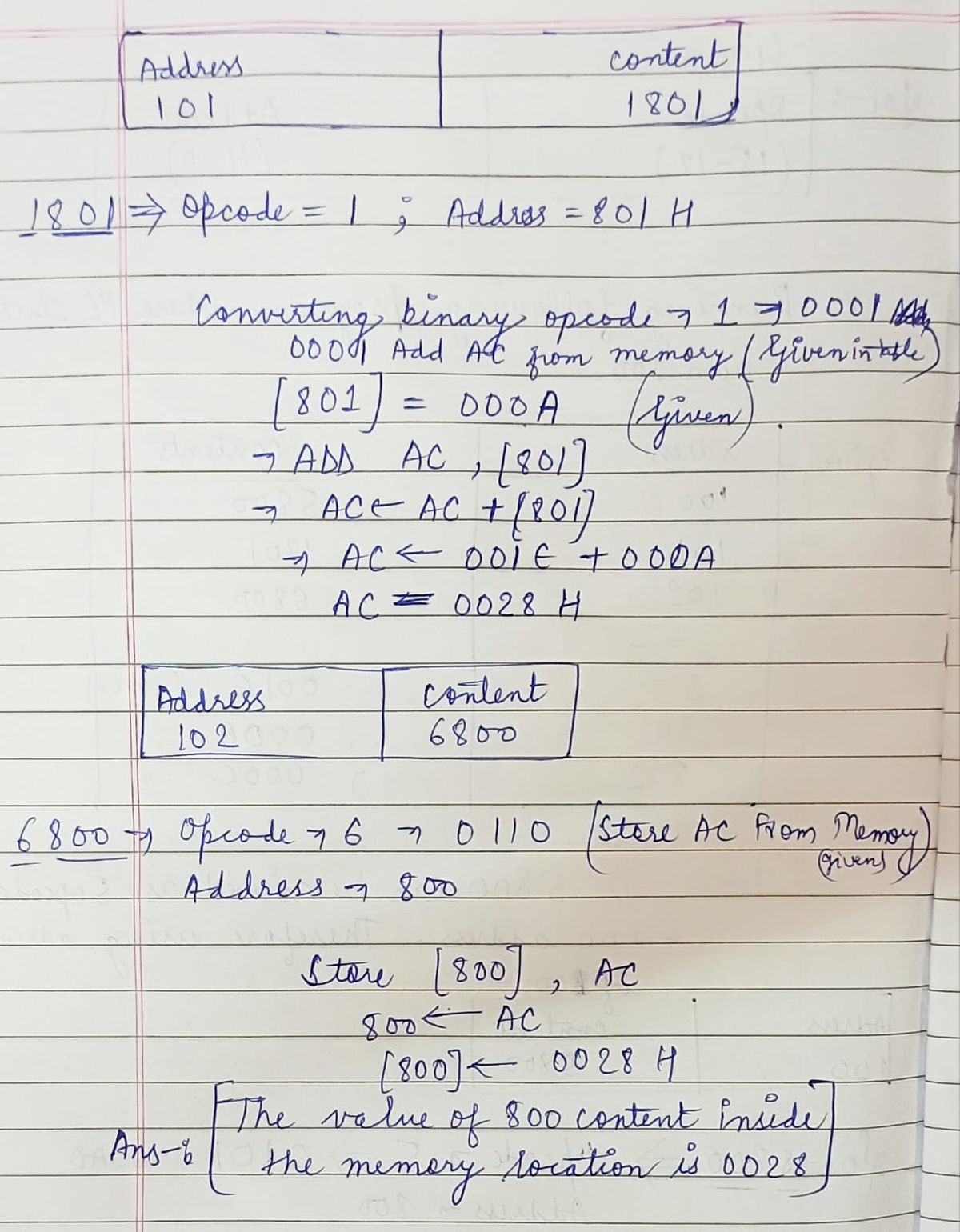
Database System Concepts
7th Edition
ISBN: 9780078022159
Author: Abraham Silberschatz Professor, Henry F. Korth, S. Sudarshan
Publisher: McGraw-Hill Education
expand_more
expand_more
format_list_bulleted
Question
![### Program Execution and Memory Analysis
#### 1. Program Execution Starting at Memory Address 100
**Memory Table:**
| Address | Contents |
|---------|----------|
| 100 | 5800 |
| 101 | 1801 |
| 102 | 6800 |
| ... | ... |
| 800 | 001F |
| 801 | 000A |
| 802 | 000C |
**Question 1:**
Upon the completion of the program, what will be the contents of the following memory address?
- Memory address 800 contents: [____]
---
#### 2. Program Execution Starting at Memory Address 210
**Memory Table:**
| Address | Contents |
|---------|----------|
| 210 | 5801 |
| 211 | 2802 |
| 212 | 6801 |
| ... | ... |
| 800 | FFFF |
| 801 | 000A |
| 802 | 0005 |
**Question 2:**
Upon the completion of the program, what will be the contents of the following memory address?
- Memory address 801 contents: [____]
- Answer all questions with hexadecimal.
---
These exercises involve understanding how a program interacts with memory and how operations alter memory addresses. Remember to analyze how each instruction affects the given memory contents.](https://content.bartleby.com/qna-images/question/44c3b237-e4ca-4e38-a278-251c2495f1b6/611c06d8-c7b9-4884-8ba2-3ad1617936b3/7nq3mq_thumbnail.png)
Transcribed Image Text:### Program Execution and Memory Analysis
#### 1. Program Execution Starting at Memory Address 100
**Memory Table:**
| Address | Contents |
|---------|----------|
| 100 | 5800 |
| 101 | 1801 |
| 102 | 6800 |
| ... | ... |
| 800 | 001F |
| 801 | 000A |
| 802 | 000C |
**Question 1:**
Upon the completion of the program, what will be the contents of the following memory address?
- Memory address 800 contents: [____]
---
#### 2. Program Execution Starting at Memory Address 210
**Memory Table:**
| Address | Contents |
|---------|----------|
| 210 | 5801 |
| 211 | 2802 |
| 212 | 6801 |
| ... | ... |
| 800 | FFFF |
| 801 | 000A |
| 802 | 0005 |
**Question 2:**
Upon the completion of the program, what will be the contents of the following memory address?
- Memory address 801 contents: [____]
- Answer all questions with hexadecimal.
---
These exercises involve understanding how a program interacts with memory and how operations alter memory addresses. Remember to analyze how each instruction affects the given memory contents.

Transcribed Image Text:### Instruction Format and Opcodes
In this section, we illustrate the instruction format and provide a list of opcodes used in a hypothetical computing system. This foundational understanding is essential for decoding and executing machine-level instructions.
#### Instruction Format
The instruction format is divided into two parts:
- **Opcode (15..12)**: This segment of the instruction specifies the operation to be performed. It consists of the four most significant bits.
- **Address (11..0)**: The remaining bits define the memory address, which is used in conjunction with the opcode to execute the instruction.
> *Note that all memory contents and addresses are hexadecimal.*
#### A Portion of the Instruction Set
The following table presents a portion of the instruction set, detailing various opcodes and their associated operations:
| Opcode | Instruction |
|--------|------------------------------------------|
| 0101 | Load AC from memory |
| 0110 | Store AC to memory |
| 0001 | Add AC from memory - AC + memory |
| 0010 | Subtract memory from AC - AC - memory |
| 0011 | Multiply AC by memory - AC * memory |
| 0100 | Divide AC by memory - AC / memory |
These opcodes demonstrate basic arithmetic and data transfer operations using an accumulator (AC) and memory interaction. This set is crucial for programmers working on low-level system programming to understand the manipulation and processing of data at the hardware level.
Expert Solution
arrow_forward
Step 1
Solution 1-
Upon completion of program the value of 800 content inside the memory location is 0028H.
- For First content 5800 the opcode is 5 and adress is 800 .Now converting opcode 5 to binary we get 0101, which is given in table as load accumulator in memory .The initial 101 instructions load the memory address 800 to AC.
- For second content 1801 the opcode is 1 so instruction by converting 1 to binary we get 0001 which is the second instructions that adds the contents at memory location 801 to AC.
- For 6800 , the third instruction Stores current value of AC to memory location.
- So value inside 800 is result of addition of contents of 800 and 801 which can be seen by proper solution of given program.



Step by stepSolved in 2 steps with 5 images

Knowledge Booster
Learn more about
Need a deep-dive on the concept behind this application? Look no further. Learn more about this topic, computer-science and related others by exploring similar questions and additional content below.Similar questions
- A successor to ASCII that includes characters from (nearly) all writtenlanguages isa) TELLI b) ASCII++ c) Unicode d) ISOarrow_forward2. How is information stored in a computer? O Data is stored in bits which are binary digits Data is stored in the CPU O Data is stored in the keyboard Data is stored on the internetarrow_forwardWhich of the following is not a way you can use what you know about memory to help you remember the names of all 50 states? A) think of something you might do in each state if you were on a vacation in that state B) memorize five states at a time—group the information into a more manageable size C) stay up the night before your exam to maximize the amount of time you have to study D) sing the names of the 50 states to the tune of “Happy Birthday”arrow_forward
- O 48 O 60 O 65 O 70 O More than 70arrow_forwardExercise 1: Convert the given decimal and hexadecimal numbers into binary numbers i. (16)10 ii. (10)10 iii. (86)10 iv. 3FA16 v. A03F16 vi. B616arrow_forwardConvert each number to its standard form. a. 7.3 × 107 a. b. 4.45 × 10−7 b. c. 8.680 ×10−2 c.arrow_forward
- The binary number 0.101101101101101101…. is equal to the decimal number (without any approximation)________. pls show workarrow_forwardWrite an algorithm using pseudocode to calculate the number of bytes in a given number of Mega bytes.arrow_forwardWhen it comes to speed, memory, and the size of arrays, today's modern digital computers are fairly incredible.arrow_forward
- ORG $0000 NUM1 DB $48 NUM2 DB $78 SUM DS 1 ORG $1000 LDAA NUM1 ADDA NUM2 STAA SUM Memory location for NUM2 is type your answer.arrow_forwardWhy does a binary digital computer always give a rough answer when it does floating-point math?arrow_forwardThe Little Man Computer Calculator Mailboxes 00 500 01 199 02 500 03 399 In Basket 95 96 97 98 99 123 Out Basket 05 Little man Instruction location counter Reset button 1. The Out instruction copies data from the a. In basket to a mailbox alculator to a mailbox c. In basket to the calculator d. mailbox to the calculator e. calculator to the In basket f. none of the abovearrow_forward
arrow_back_ios
SEE MORE QUESTIONS
arrow_forward_ios
Recommended textbooks for you
 Database System ConceptsComputer ScienceISBN:9780078022159Author:Abraham Silberschatz Professor, Henry F. Korth, S. SudarshanPublisher:McGraw-Hill Education
Database System ConceptsComputer ScienceISBN:9780078022159Author:Abraham Silberschatz Professor, Henry F. Korth, S. SudarshanPublisher:McGraw-Hill Education Starting Out with Python (4th Edition)Computer ScienceISBN:9780134444321Author:Tony GaddisPublisher:PEARSON
Starting Out with Python (4th Edition)Computer ScienceISBN:9780134444321Author:Tony GaddisPublisher:PEARSON Digital Fundamentals (11th Edition)Computer ScienceISBN:9780132737968Author:Thomas L. FloydPublisher:PEARSON
Digital Fundamentals (11th Edition)Computer ScienceISBN:9780132737968Author:Thomas L. FloydPublisher:PEARSON C How to Program (8th Edition)Computer ScienceISBN:9780133976892Author:Paul J. Deitel, Harvey DeitelPublisher:PEARSON
C How to Program (8th Edition)Computer ScienceISBN:9780133976892Author:Paul J. Deitel, Harvey DeitelPublisher:PEARSON Database Systems: Design, Implementation, & Manag...Computer ScienceISBN:9781337627900Author:Carlos Coronel, Steven MorrisPublisher:Cengage Learning
Database Systems: Design, Implementation, & Manag...Computer ScienceISBN:9781337627900Author:Carlos Coronel, Steven MorrisPublisher:Cengage Learning Programmable Logic ControllersComputer ScienceISBN:9780073373843Author:Frank D. PetruzellaPublisher:McGraw-Hill Education
Programmable Logic ControllersComputer ScienceISBN:9780073373843Author:Frank D. PetruzellaPublisher:McGraw-Hill Education

Database System Concepts
Computer Science
ISBN:9780078022159
Author:Abraham Silberschatz Professor, Henry F. Korth, S. Sudarshan
Publisher:McGraw-Hill Education

Starting Out with Python (4th Edition)
Computer Science
ISBN:9780134444321
Author:Tony Gaddis
Publisher:PEARSON

Digital Fundamentals (11th Edition)
Computer Science
ISBN:9780132737968
Author:Thomas L. Floyd
Publisher:PEARSON

C How to Program (8th Edition)
Computer Science
ISBN:9780133976892
Author:Paul J. Deitel, Harvey Deitel
Publisher:PEARSON

Database Systems: Design, Implementation, & Manag...
Computer Science
ISBN:9781337627900
Author:Carlos Coronel, Steven Morris
Publisher:Cengage Learning

Programmable Logic Controllers
Computer Science
ISBN:9780073373843
Author:Frank D. Petruzella
Publisher:McGraw-Hill Education